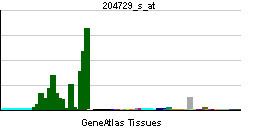Entrez 6804 | Ensembl ENSG00000106089 | |
 | ||
External IDs MGI: 109355 HomoloGene: 37941 GeneCards: STX1A | ||
Function
Synaptic vesicles store neurotransmitters that are released during calcium-regulated exocytosis. The specificity of neurotransmitter release requires the localization of both synaptic vesicles and calcium channels to the presynaptic active zone. Syntaxins function in this vesicle fusion process.
Syntaxin-1A is a member of the syntaxin superfamily. Syntaxins are nervous system-specific proteins implicated in the docking of synaptic vesicles with the presynaptic plasma membrane. Syntaxins possess a single C-terminal transmembrane domain, a SNARE [Soluble NSF (N-ethylmaleimide-sensitive fusion protein)-Attachment protein REceptor] domain (known as H3), and an N-terminal regulatory domain (Habc). Syntaxins bind synaptotagmin in a calcium-dependent fashion and interact with voltage dependent calcium and potassium channels via the C-terminal H3 domain. Syntaxin-1A is a key protein in ion channel regulation and synaptic exocytosis.
Clinical significance
Syntaxins serve as a substrate for botulinum neurotoxin type C, a metalloprotease that blocks exocytosis and has high affinity for a molecular complex that includes the alpha-latrotoxin receptor which produces explosive exocytosis.
The expression level of STX1A is directly correlated with intelligence in Williams Syndrome.
Interactive pathway map
Click on genes, proteins and metabolites below to link to respective articles.
Interactions
STX1A has been shown to interact with:
